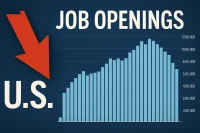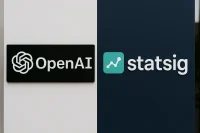In a surprising show of resilience, the US economy added 254,000 jobs in September, outpacing economists’ predictions and underscoring the continued strength of the labor market.
This unexpected surge, reported by the Bureau of Labor Statistics on Friday, marks a significant boost from August’s revised job gains of 159,000 and offers reassurance that the US job market remains robust even as other economic indicators fluctuate.
The unemployment rate dropped slightly from 4.2 percent to 4.1 percent, signaling a more optimistic outlook for the labor market’s health.
The impressive job growth highlights the potential for a “soft landing” — a scenario where inflation can be controlled without plunging the economy into a recession.
Service Sector Drives Job Growth
The September job gains were largely fueled by the service sector, which contributed 202,000 of the 254,000 new jobs. Within this sector, the healthcare, leisure and hospitality industries stood out, adding 71,700 and 78,000 jobs, respectively.
These gains reflect growing demand for services as the public continues to shift spending from goods to experiences and healthcare needs.
On the other hand, goods-producing industries saw more muted growth.
The construction sector defied pre-pandemic averages by adding 25,000 jobs, yet the manufacturing sector, which employs nearly 13 million Americans, reported a loss of 7,000 jobs.
This decline is a reminder that while the service sector thrives, certain areas of manufacturing continue to face challenges, possibly influenced by broader global supply chain issues.
What the Job Growth Means for the Federal Reserve
The Federal Reserve has been closely monitoring employment data, as it seeks to balance its dual mandate of controlling inflation and maximizing employment.
September’s unexpectedly strong job report suggests that the Fed may not need to take drastic actions in the immediate term to stimulate job growth.
In fact, with inflation seemingly under control, the Fed could have more room to focus on maintaining stable employment.
Chris Rupkey, chief economist at FwdBonds LLC, emphasized the positive outlook: “The economic expansion remains on course for now. The outlook for the economy in the months ahead is quite favorable, according to the September jobs report.”
Need Career Advice? Get employment skills advice at all levels of your career
Strong Job and Wage Gains Ease Economic Concerns
In addition to job growth, wages have shown a steady increase. Average hourly earnings rose by 0.4 percent in September, bringing the annual rate to 4 percent, up from 3.9 percent in August.
This increase in wages has been a consistent trend over the past 16 months, with nominal wages rising faster than inflation.
As a result, real wages and purchasing power are improving, which is a positive sign for household finances and overall living standards.
Elise Gould, senior economist at the Economic Policy Institute, remarked on the labor market’s current state: “The labor market is strong. Real wage growth is up, and a lot of jobs have been added. When compared to both pre-pandemic and pandemic levels, the current state is much stronger.”
So far, the US has added an average of 199,000 jobs per month in 2023.
While this figure is lower than the 251,083 jobs added monthly on average in 2022, it still exceeds pre-pandemic levels, marking the 45th consecutive month of positive job growth — the fourth-longest streak on record.
Implications for Future Federal Reserve Rate Decisions

September’s job growth may also have implications for the Federal Reserve’s upcoming decisions on interest rates.
In recent months, the Fed has shifted its focus from aggressive inflation control to a more measured approach aimed at supporting employment.
Just last month, the Fed made a half-point rate cut, signaling a pivot to more accommodative monetary policy.
Brian Bethune, an economist at Boston College, explained that the recent rate cuts signal a positive outlook for businesses, especially small businesses that rely on stable borrowing costs: “The move by the Federal Reserve was a positive signal… If businesses were holding back on hiring due to uncertainty, they now see relief on the horizon and can proceed with hiring plans that had been delayed.”
Josh Hirt, senior US economist at Vanguard, suggested that September’s job report reinforces the Fed’s current stance: “I think that [the Fed] will continue with a relatively deliberate plan of rate cuts. There’s a high bar for them to pause altogether, given what they’ve started.”
A Bright Spot for the US Labor Market
September’s job gains underscore the resilience of the US economy, even as it faces headwinds like fluctuating demand for goods and the potential impacts of ongoing labor strikes and natural disasters.
The Bureau of Labor Statistics anticipates that upcoming reports may show temporary distortions from events such as the recent Boeing strike and Hurricane Helene.
Nevertheless, September’s strong report provides a reassuring picture of job growth, wage increases, and a gradual return to economic stability.
The future of the labor market looks promising as employers show confidence in hiring, buoyed by favorable interest rate policies and steady consumer demand.
As the economy moves into the final quarter of the year, the strong September jobs report offers hope for a positive end to 2023, with continued job opportunities and rising wages enhancing financial security for workers nationwide.




